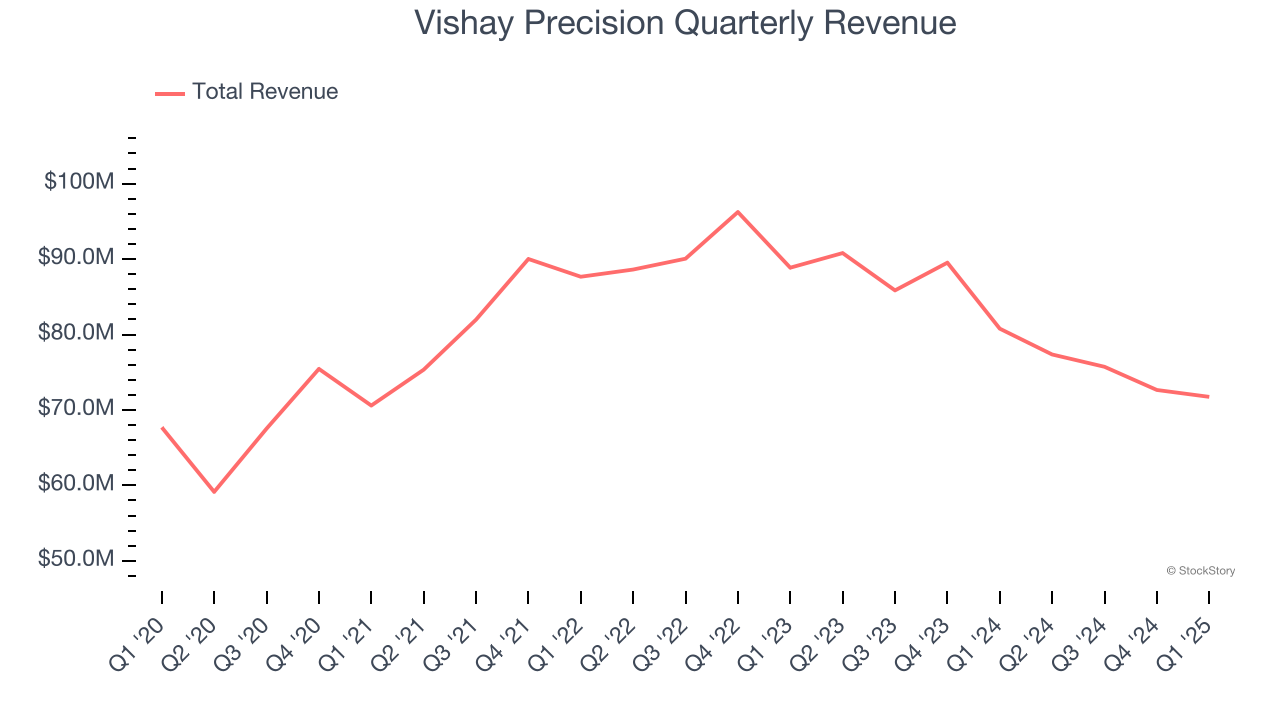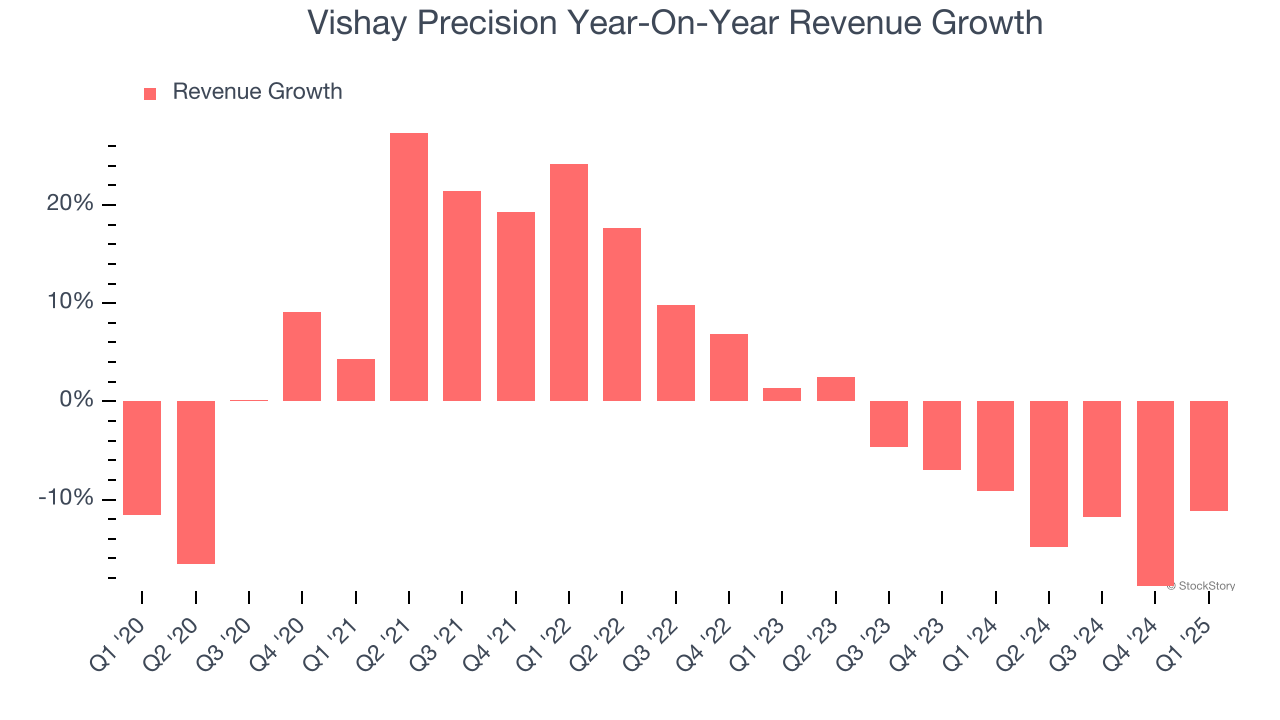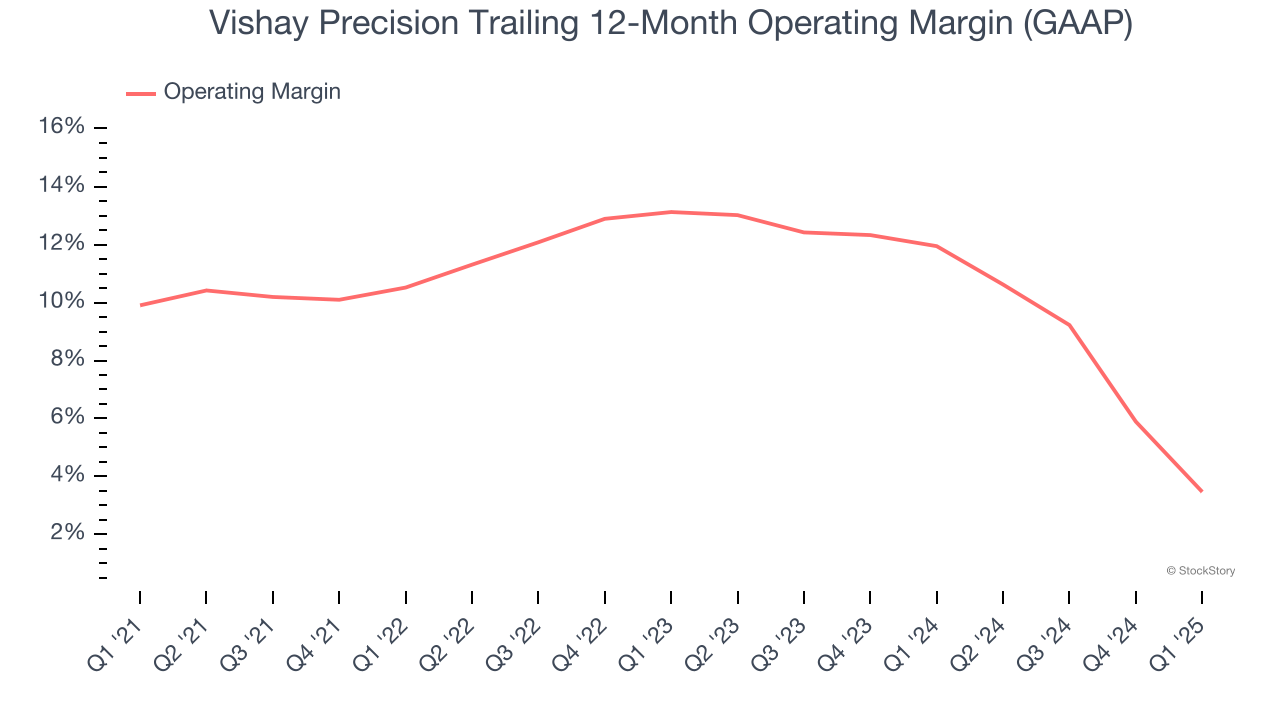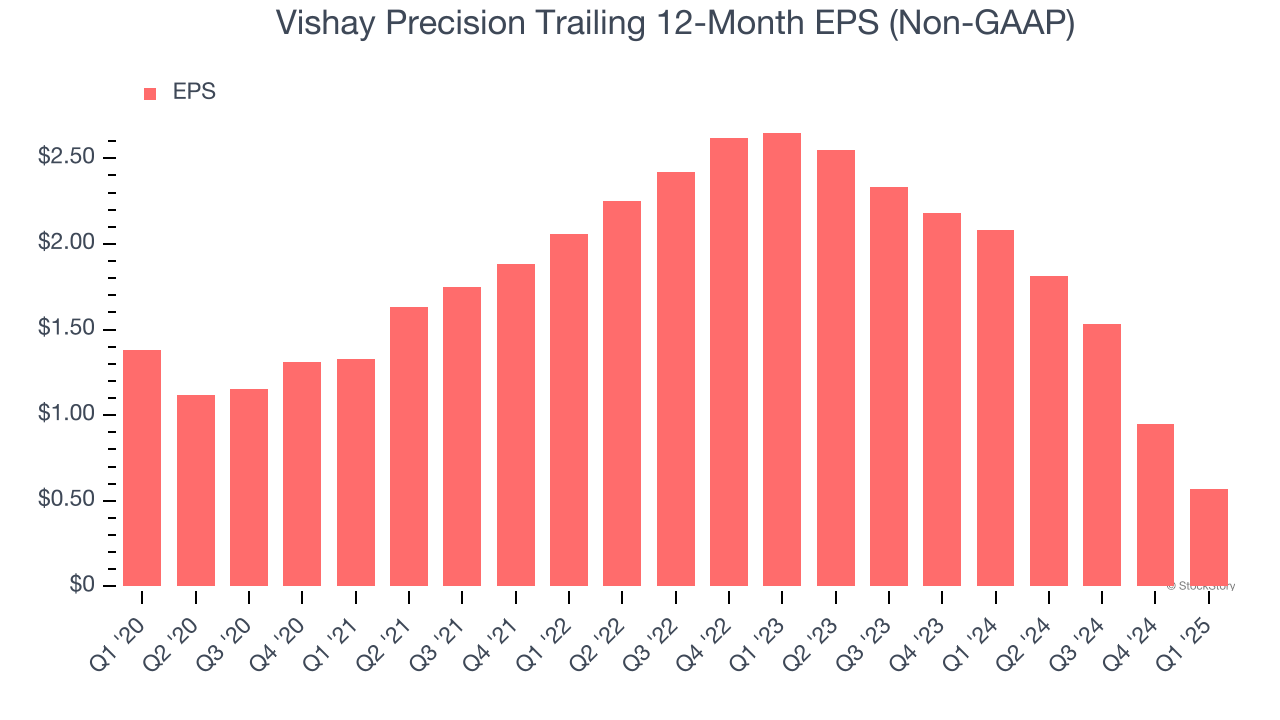
Precision measurement and sensing technologies provider Vishay Precision (NYSE: VPG) missed Wall Street’s revenue expectations in Q1 CY2025, with sales falling 11.2% year on year to $71.74 million. Next quarter’s revenue guidance of $73 million underwhelmed, coming in 3.6% below analysts’ estimates. Its non-GAAP profit of $0.04 per share was 42.9% below analysts’ consensus estimates.
Is now the time to buy Vishay Precision? Find out by accessing our full research report, it’s free.
Vishay Precision (VPG) Q1 CY2025 Highlights:
- Revenue: $71.74 million vs analyst estimates of $73.02 million (11.2% year-on-year decline, 1.7% miss)
- Adjusted EPS: $0.04 vs analyst expectations of $0.07 (42.9% miss)
- Adjusted EBITDA: $5.14 million vs analyst estimates of $5.67 million (7.2% margin, 9.3% miss)
- Revenue Guidance for Q2 CY2025 is $73 million at the midpoint, below analyst estimates of $75.71 million
- Operating Margin: -0.1%, down from 9.5% in the same quarter last year
- Free Cash Flow Margin: 5.2%, similar to the same quarter last year
- Market Capitalization: $331.4 million
Ziv Shoshani, Chief Executive Officer of VPG, commented, "Despite the continuing challenging business environment, we achieved the second consecutive quarter of book-to-bill over 1.00. Total orders of $74.4 million grew 2.7% sequentially and resulted in a book-to-bill of 1.04, as our Sensors and Measurement Systems reporting segments recorded book-to-bill ratios above 1.00. As the global economy faces increasing volatility due to rapidly changing tariff and trade policies, we believe our manufacturing footprint and strategy position us to navigate the direct impacts of these policies. We continue to focus on our business development growth initiatives, and are pleased with the progress thus far in our humanoid robot opportunities, among others."
Company Overview
Emerging from Vishay Intertechnology in 2010, Vishay Precision (NYSE: VPG) operates as a global provider of precision measurement and sensing technologies.
Sales Growth
Reviewing a company’s long-term sales performance reveals insights into its quality. Any business can have short-term success, but a top-tier one grows for years. Over the last five years, Vishay Precision grew its sales at a sluggish 1.6% compounded annual growth rate. This was below our standards and is a poor baseline for our analysis.

We at StockStory place the most emphasis on long-term growth, but within industrials, a half-decade historical view may miss cycles, industry trends, or a company capitalizing on catalysts such as a new contract win or a successful product line. Vishay Precision’s performance shows it grew in the past but relinquished its gains over the last two years, as its revenue fell by 9.6% annually. Vishay Precision isn’t alone in its struggles as the Electronic Components industry experienced a cyclical downturn, with many similar businesses observing lower sales at this time. 
This quarter, Vishay Precision missed Wall Street’s estimates and reported a rather uninspiring 11.2% year-on-year revenue decline, generating $71.74 million of revenue. Company management is currently guiding for a 5.6% year-on-year decline in sales next quarter.
Looking further ahead, sell-side analysts expect revenue to grow 6% over the next 12 months. Although this projection indicates its newer products and services will catalyze better top-line performance, it is still below the sector average.
Unless you’ve been living under a rock, it should be obvious by now that generative AI is going to have a huge impact on how large corporations do business. While Nvidia and AMD are trading close to all-time highs, we prefer a lesser-known (but still profitable) stock benefiting from the rise of AI. Click here to access our free report one of our favorites growth stories.
Operating Margin
Operating margin is one of the best measures of profitability because it tells us how much money a company takes home after procuring and manufacturing its products, marketing and selling those products, and most importantly, keeping them relevant through research and development.
Vishay Precision has managed its cost base well over the last five years. It demonstrated solid profitability for an industrials business, producing an average operating margin of 10%. This result isn’t surprising as its high gross margin gives it a favorable starting point.
Looking at the trend in its profitability, Vishay Precision’s operating margin decreased by 6.4 percentage points over the last five years. This raises questions about the company’s expense base because its revenue growth should have given it leverage on its fixed costs, resulting in better economies of scale and profitability.

This quarter, Vishay Precision’s breakeven margin was down 9.6 percentage points year on year. Since Vishay Precision’s operating margin decreased more than its gross margin, we can assume it was less efficient because expenses such as marketing, R&D, and administrative overhead increased.
Earnings Per Share
We track the long-term change in earnings per share (EPS) for the same reason as long-term revenue growth. Compared to revenue, however, EPS highlights whether a company’s growth is profitable.
Sadly for Vishay Precision, its EPS declined by 16.2% annually over the last five years while its revenue grew by 1.6%. This tells us the company became less profitable on a per-share basis as it expanded due to non-fundamental factors such as interest expenses and taxes.

Diving into the nuances of Vishay Precision’s earnings can give us a better understanding of its performance. As we mentioned earlier, Vishay Precision’s operating margin declined by 6.4 percentage points over the last five years. This was the most relevant factor (aside from the revenue impact) behind its lower earnings; taxes and interest expenses can also affect EPS but don’t tell us as much about a company’s fundamentals.
Like with revenue, we analyze EPS over a shorter period to see if we are missing a change in the business.
For Vishay Precision, its two-year annual EPS declines of 53.6% show it’s continued to underperform. These results were bad no matter how you slice the data.
In Q1, Vishay Precision reported EPS at $0.04, down from $0.42 in the same quarter last year. This print missed analysts’ estimates. Over the next 12 months, Wall Street expects Vishay Precision’s full-year EPS of $0.57 to grow 112%.
Key Takeaways from Vishay Precision’s Q1 Results
We struggled to find many positives in these results. Its EBITDA missed significantly and its EPS fell short of Wall Street’s estimates. Overall, this quarter could have been better. The stock traded down 4.3% to $23.83 immediately after reporting.
Vishay Precision didn’t show it’s best hand this quarter, but does that create an opportunity to buy the stock right now? We think that the latest quarter is only one piece of the longer-term business quality puzzle. Quality, when combined with valuation, can help determine if the stock is a buy. We cover that in our actionable full research report which you can read here, it’s free.







